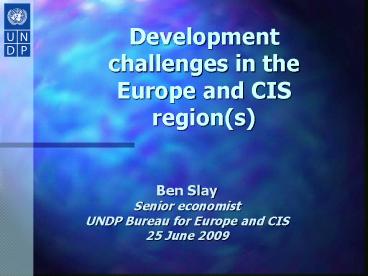Development challenges in the Europe and CIS region(s) - PowerPoint PPT Presentation
1 / 15
Title:
Development challenges in the Europe and CIS region(s)
Description:
Response to the global economic crisis. Climate change transitions to low carbon economies ... Economic crisis is now changing this 'Transition recession' ... – PowerPoint PPT presentation
Number of Views:55
Avg rating:3.0/5.0
Title: Development challenges in the Europe and CIS region(s)
1
Development challenges in the Europe and CIS
region(s)
- Ben Slay
- Senior economist
- UNDP Bureau for Europe and CIS
- 25 June 2009
2
Key points
- Region or regions? Country differences and
commonalities - Shared development challenges
- Response to the global economic crisis
- Climate change ?? transitions to low carbon
economies - Improvements in governance, state capacity
3
Region or regions? Differences commonalities
- Major differences among EU-12, Western Balkans,
CIS countries - Four overlapping commonalities
- European orientation
- Accession, candidacy, neighbourhood
- Post-communist legacies
- Transition challenges
- New states Successors to USSR, Yugoslavia,
Czechoslovakia - State capacity challenges
- Emerging markets
- Vulnerability to global financial crisis
4
Commonalities ? cooperation
- New EU member statesSuccess stories in
- Single market access, competitiveness
- Economic transition, modernisation
- Stable, consolidated parliamentary
democraciesElectoral outcomes are - Not known in advance
- Accepted by losers
- Such accomplishments
- Are appreciated in partner countries
- Can be the basis for supply of development
cooperation services from new member states
5
Key commonality Transition and growth
- Transition creates U- or J-shaped economic
growth paths, reflecting - Transition recession
- Recovery growth
- Typical of almost all transition economies
- Irrespective of energy prices, exports, EU
membership - Economic crisis is now changing this
Transition recession
Recovery growth
Transition recession
6
Common emerging market vulnerability
Regional GDP growth trends
Source IMF World Economic Outlook, April 2009
7
IMF country forecasts
Source IMF World Economic Outlook, April 2009
8
So far, many EU-12 countries are holding up
Numbers of unemployed (LFS data), June 2008 100
Source Eurostat
9
Possible lessons from EU-12 for programme
countries?
- In preparation for membership, new EU member
states - Significantly improved
- Business environment
- Investment climate
- Developed capacity for more effective policies
in - Social inclusion/flexicurity
- Regional development
- Strengthened absorption capacity for EU funding
- Clear relevance for accession, neighbourhood
countries
10
Climate change Commonalities, partnerships
- Both EU-12, programme countries inherited very
energy inefficient economies - ResultsHigh levels of
- Energy use
- Greenhouse gas emissions
- Both groups of countries have
- Incentives to attract carbon finance under Kyoto,
post-Kyoto mechanisms - Common interests in run-up to Copenhagen climate
change summit (December 2009)
11
In 1990 Programme, EU-12 countries emit lots of
CO2
CO2 emitted per of GDP
Kilotons emitted per million PPP GDP. Source
UNDP Human Development Report Office.
12
By 2004 Slovakia, Romania were below global
averages
CO2 emitted per of GDP
Kilotons emitted per million PPP GDP. Source
UNDP Human Development Report Office.
13
Possible lessons from EU-12 for programme
countries?
- In preparation for membership, EU-12
- Modernised their energy sectors via
- Foreign direct investment
- Adoption of acquis communautaires energy,
environmental chapters, policy frameworks - Began
- Paying cost-recovery prices for energy
- Accessing Kyoto cap-and-trade carbon finance
- After accession, they learned to participate in
European Trading System - Clear relevance for accession, ENP countries
14
Conclusions
- There are clear differences between and among
EU-12, programme countries - But important commonalities remain, in terms of
- Demand-supply relationships vis-à-vis
transition-related expertise - Common interests in reforms to
- Domestic political, economic institutions
- Global governance frameworks
15
Estonia































